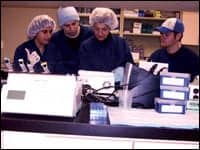All over the world governments are funding and researchers are spending millions to identify biomarker tests for an array of diseases:
 |
- For lung cancer, an inexpensive, noninvasive biomarker test based on DNA harvested from a patient’s sputum is being developed.
- For breast cancer, researchers have identified and linked a structural protein called nestin to an especially deadly form of breast cancer. Another group has found the expression of two different proteins taken from primary tumor biopsies. Such a protein profile could help identify patients most at risk of having their cancer metastasize.
- For Alzheimer’s, development of a biomarker ranks high on the agenda of both the European Commission and the US National Institutes of Health. Using a study of about 100 patients late last year, researchers at two New York facilities identified 23 biomarker proteins for the disease. Ahead are more extensive trials. Here’s a look at three recent biomarkers and the companies behind them.
Congestive Heart Failure
What is being called the first true point of care (POC) diagnostic test system covering the entire clinical range for the congestive heart failure (CHF) marker NT-proBNP appears headed for sales to the US market later this spring. Response Biomedical Corp, with headquarters in British Columbia, Canada, has been working under license from Roche Diagnostics GmbH to develop its new RAMP NT-proBNP protein biomarker since mid-August 2005.
Globally, CHF is the most frequent cause of hospitalization in people older than 65 years. Diagnosis can be difficult because it shares symptoms with other diseases. The American Heart Association says 5 million Americans now have CHF and 550,000 new patients are diagnosed yearly. The CHF testing market exceeds $400 million annually in the United States, with strong growth driven by a market need for improved detection, prognosis, and monitoring.
The company received a CE Mark for European application in December. Officials said they have been pleased by interest and initial response to the new test. The RAMP NT-proBNP test has completed clinical trials at hospitals in the United States, including the Mayo Clinic in Minneapolis and Massachusetts General Hospital in Boston. Response has filed an FDA 510(k) for regulatory clearance.
Gavin Arthur, PhD, product manager for clinical lines at Response, said most but not all biomarkers are proteins, or peptides, that are analyzed with today’s clinical labs using advanced immunodiagnostic systems.
Lab analyzers and emerging POC tests like the RAMP NT-proBNP have to be able to use the most specific antibodies available to identify just the marker of interest, while ignoring interfering substances.
“The extra challenge for true POC tests such as RAMP is to allow the test to run on whole blood or samples that have not been preprocessed—such as with centrifugation—something the big lab systems can do as part of the testing procedures,” Arthur says. “We use EDTA whole blood, which allows rapid sample testing, but these samples also contain more possible confounding proteins.”
According to Arthur, improving test sensitivity is a constant challenge with immunodiagnostics. “At some point, that sensitivity becomes limiting as you reduce the time that samples can interact with the antibodies,” he says. “POC tests deliver the rapid results that are needed to improve patient care, but that speed increases the challenge of keeping analytical sensitivity high. Patented RAMP technology maximizes the sensitivity that can be achieved by point of care.”
Disease biomarkers now can be tested by lab systems and POC systems in emergency departments. In some cases, they can be run in doctors’ offices. “But as the test location moves away from the lab and out to doctors’ offices or small clinics, the current regulations require the tests to be easy to use,” Arthur says. “And most importantly, that the results provided cannot be misinterpreted.”
In terms of new biomarkers’ impact on the laboratory business, as costs of POC tests decline and more relevant biomarkers are developed (such as early cancer markers and others), these test options will take market away from the current system of sending all samples from the doctor’s office to reference labs or hospital labs.
“Of course, right now, the cost-per-test argument is being won by the lab systems because they can process so many tests at once,” Arthur says.
Biomarkers are emerging on a larger scale as researchers gain knowledge of which proteins are released by certain kinds of diseases, says Arthur. One of the first examples of this is Prostate Serum Antigen (PSA) testing. Higher levels of this protein in the patient’s blood tells the physician whether the patient has a higher chance of abnormal prostate growth (for example tumor growth).
“Many more of these biomarker candidates are in development as the area of proteomics identifies with more certainty the specific markers for specific diseases,” Arthur says. The result is earlier detection of some diseases, since a biomarker can be present in the blood well before any symptoms surface in the patient.
“Coming back to the PSA example, this is now used to screen men over a certain age as an earlier indicator of prostate cancer. The market is therefore growing as technology reveals more markers and as the clinical value of these is understood as either early warning indicators or even as markers to evaluate the effectiveness of therapies,” he says.
Ellen Miller, Response Biomedical’s director of sales and marketing, said development of the RAMP NT-proBNP biomarker was fairly straightforward. Driving interest in biomarkers, she says, is their ability to provide the diagnostics industry with a larger market in which companies can participate. “The CHF markers NT-proBNP and Brain Natriuretic Peptide are an example where these new tests do not replace another diagnostic or set of diagnostics, but actually introduce a specific class of biomarkers for the detection and monitoring of a disease for which there were no previous diagnostic biomarkers,” she says.
Alzheimer’s, Parkinson’s, Etc
Power3 Medical Products, based near Houston, boasts a 13-person staff of young biochemists and experienced PhDs who have concentrated on proteomics since May 2004. The small company has already filed for 16 patents for its blood serum biomarkers for early detection of breast cancer and early detection of such neurodegenerative diseases as Alzheimer’s and Parkinson’s. In the coming months, it expects to file patent applications for up to a half-dozen more.
“We’re a biomarker factory. We identify biomarkers, validate and then quantify them,” says Power3 Chairman and CEO Steven Rash. Unlike genomics, which aims to reveal patient susceptibilities to disease, proteomics identifies protein profiles—direct evidence of the presence of specific diseases.
Using two-dimension gel electrophoresis complemented by its own proprietary software, Power3 researchers are able to identify individual proteins, Rash says. More commonly used mass spectrometry is effective at mapping protein peaks and valleys, but lacks much specificity.
Distinguishing Alzheimer’s from other forms of dementia ranks among the most critical issues in medicine today, Rash says. “It’s hard to believe that despite the forecasts for growth of Alzheimer’s cases in this country, there are no blood tests currently in the FDA pipeline as a diagnostic tool for the early detection of the disease,” Rash says.
 |
| Power3 Medical Products, based near Houston, is referred to as a “biomarker factory” by Chairman and CEO Steven Rash. |
Power3 is planning four versions of its NuroPro™ blood serum-based test for early detection and for diagnosing Alzheimer’s and other related neurodegenerative diseases. The biomarkers to be used for the early detection tests are now available to be commercialized as a home brew test; Rash sees them moving to the commercialization phase—with licensing to a major test manufacturer and marketer —sometime in early 2008.
To guard against variations, Rash says, his laboratory runs every blood serum sample in triplicate. “Lots of companies can claim biomarker advances, but they can’t assure reproducibility,” he says. “Reproducibility is no longer an issue at Power3 because of our expertise in proteomics and our patent-pending technologies.”
Power3 researchers, many in their early 20s, work in a relaxed and casual environment. Unlike many labs that changed focus after the genome project, Rash says, his young staff is driven by biomarker development and the impact they can make in the future.
“We talk constantly about what we’re doing as a team,” he says. “We encourage everyone to present to the team as soon as they have something to share.”
Rash concedes that his company’s successes could make it an acquisition target for much larger firms. “We would welcome being acquired by the right strategic partner who understands proteomics and the role biomarkers play, and will keep us doing what we do.”
Prostate Cancer Biomarker
San Diego-based Gen-Probe has been developing nucleic acid tests for use by clinical laboratories and blood screening facilities for more than 2 decades, says Harry Rittenhouse, PhD, senior director of its cancer diagnostics program.
Rittenhouse says Gen-Probe’s new biomarker assay, a molecular urine test called PCA3, targets a highly specific prostate cancer gene. The new biomarker has shown promise of being a more accurate predictor of prostate cancer than the long accepted Prostate Specific Antigen test (PSA). Used in conjunction with the PSA, the new biomarker should reduce false positives and free patients from more expensive and more invasive tests. In general, 15% of initial PSA tests show elevated PSA levels, even though little more than a quarter of that number actually detect cancer. “Our PCA3 test appears to have 75% to 80% specificity, versus 25% to 30% for PSA,” Rittenhouse says. In some populations, such as patients with previous negative biopsies, PSA has even lower specificity. Gen-Probe acquired exclusive worldwide diagnostic rights to the PCA3 gene from DiagnoCure in November 2003.
Rittenhouse says that a number of issues have to be addressed before a biomarker can make a successful translation from research to clinical laboratory uses. “There has to be commercial interest to move it along, a full regulatory process to satisfy, and the reimbursement issue,” he says.The PCA3 test, he says, can measure a gene that is overexpressed within a cancer cell and therefore directly detect cancer. Already available as a CE-marked product in Europe, the new test is now being used as an Analyte-Specific Reagent in the United States. Regarding Gen-Probe’s work on other biomarkers, Rittenhouse says the genes AMACR and ERG and the prostate cancer-specific gene fusions containing the ERG gene will prove valuable in combination with PCA3 for multiple unmet clinical needs in the management of prostate cancer.
Nicholas Borgert is a contributing writer for CLP. For more information, contact .



